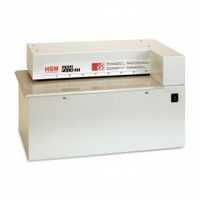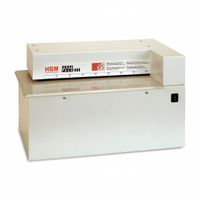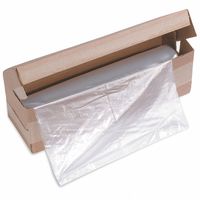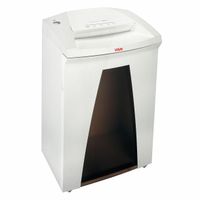Call +(254) 703 030 000 / 751 483 999 / 721 704 777
- Home
- Office Supplies
- Paper Shredders Paper Cutters And Paper Folding Machines
- Paper Shredders Paper Shredder Bags
.....Read More
Frequently Asked Questions
What is the best paper shredder for home use?
The best paper shredder for home use is the Fellowes Powershred 79Ci. This model is highly recommended due to its combination of performance, safety features, and ease of use. It offers a cross-cut shredding capability, which provides a higher level of security by turning documents into small confetti-like pieces, making it difficult for anyone to reconstruct sensitive information.
The 79Ci can shred up to 16 sheets of paper per pass, which is efficient for home use. It also handles staples, paper clips, credit cards, and CDs/DVDs, adding versatility to its functionality. The shredder features a 6-gallon pull-out bin, which is convenient for easy disposal and reduces the frequency of emptying.
One of the standout features of the Fellowes 79Ci is its 100% Jam Proof System, which prevents paper jams and powers through tough jobs. Additionally, it has a SafeSense Technology that automatically stops the shredder when hands touch the paper opening, ensuring safety for households with children or pets.
The shredder operates quietly, making it suitable for home environments where noise can be a concern. Its energy-saving system reduces energy consumption, making it an eco-friendly choice. The design is compact and stylish, allowing it to fit seamlessly into a home office setup.
Overall, the Fellowes Powershred 79Ci balances security, efficiency, and user-friendly features, making it the best choice for home use.
How do I choose the right paper shredder for my office?
To choose the right paper shredder for your office, consider the following factors:
1. **Security Level**: Determine the sensitivity of the documents you need to shred. Shredders are classified by DIN levels (P-1 to P-7). For general office use, a P-3 or P-4 shredder is sufficient. For highly confidential documents, opt for P-5 or higher.
2. **Sheet Capacity**: Assess how many sheets you need to shred at once. Small offices might manage with a 5-10 sheet capacity, while larger offices may require shredders that handle 20+ sheets.
3. **Shredder Type**: Choose between strip-cut, cross-cut, or micro-cut shredders. Strip-cut offers basic security, cross-cut provides medium security and reduces waste volume, while micro-cut offers the highest security.
4. **Bin Size**: Consider the volume of paper waste your office generates. A larger bin size reduces the frequency of emptying. For high-volume shredding, a bin size of 20 gallons or more is ideal.
5. **Run Time and Cool Down**: Continuous run time is crucial for high-volume shredding. Look for shredders with longer run times and shorter cool-down periods to maintain productivity.
6. **Additional Features**: Consider features like jam-proof technology, auto-feed, safety sensors, and energy-saving modes. These can enhance efficiency and safety.
7. **Noise Level**: For a quiet office environment, choose a shredder with a low decibel rating.
8. **Budget**: Balance your needs with your budget. While higher security and capacity shredders cost more, they may offer better long-term value.
9. **Brand and Warranty**: Opt for reputable brands known for durability and customer support. Check the warranty for peace of mind.
By evaluating these factors, you can select a shredder that meets your office's security, capacity, and budgetary needs.
Can paper shredder bags be recycled?
Yes, paper shredder bags can be recycled, but it depends on the material they are made from. If the bags are made of paper, they can typically be recycled along with other paper products, provided they are clean and free from contaminants like plastic or metal. It's important to check with your local recycling program to ensure they accept paper bags, as recycling guidelines can vary by location.
On the other hand, if the shredder bags are made of plastic, their recyclability depends on the type of plastic used. Many plastic bags are made from polyethylene, which is recyclable, but they often require special handling. These bags should not be placed in curbside recycling bins as they can tangle in the machinery at recycling facilities. Instead, they should be taken to designated drop-off locations, often found at grocery stores or recycling centers, that accept plastic bags for recycling.
It's also worth considering alternatives to using shredder bags. For instance, you can directly empty the shredded paper into a recycling bin or compost it if the paper is free from ink or other contaminants. Composting is an environmentally friendly option, especially for non-glossy, non-colored paper.
In summary, whether paper shredder bags can be recycled depends on their material. Paper bags are generally recyclable, while plastic bags require special handling. Always check local recycling guidelines to ensure proper disposal.
How often should I oil my paper shredder?
You should oil your paper shredder every time you empty the wastebasket or after every 30 minutes of continuous use. Regular oiling is essential to maintain the shredder's performance and prolong its lifespan. For light to moderate use, oiling once a month is generally sufficient. However, if you use the shredder heavily, consider oiling it more frequently, such as weekly or bi-weekly.
To oil the shredder, use a specially formulated shredder oil or lubricant sheets. Avoid using aerosol oils or any other type of lubricant, as they can damage the shredder. To apply the oil, you can either drizzle it directly onto a piece of paper and run it through the shredder or use pre-oiled sheets. Ensure the oil is evenly distributed across the blades.
Signs that your shredder needs oiling include unusual noises, reduced shredding speed, or paper jams. Regular maintenance, including oiling, helps prevent these issues by reducing friction and keeping the blades sharp. Always refer to the manufacturer's instructions for specific guidance on oiling frequency and methods, as different models may have varying requirements.
What materials can industrial shredders handle?
Industrial shredders are versatile machines capable of handling a wide range of materials. They are designed to process and reduce the size of various materials for recycling, disposal, or further processing. Here are some materials that industrial shredders can handle:
1. **Plastics**: Industrial shredders can process different types of plastics, including PET, HDPE, PVC, and more. They are used in recycling facilities to break down plastic waste into smaller pieces for reprocessing.
2. **Metals**: Shredders can handle both ferrous and non-ferrous metals. They are used to shred aluminum, copper, steel, and other metal scraps, making them easier to transport and recycle.
3. **Wood**: Wood shredders are used in the lumber and construction industries to process wood waste, pallets, and other wooden materials into chips or sawdust.
4. **Paper and Cardboard**: Shredders are commonly used in the paper industry to recycle paper and cardboard products, turning them into smaller pieces for pulping and recycling.
5. **Tires**: Tire shredders are designed to process used tires, breaking them down into smaller pieces for recycling into new products or for use as fuel.
6. **Textiles**: Shredders can handle various textiles, including clothing, fabric scraps, and carpets, reducing them to fibers for recycling or disposal.
7. **Electronics**: E-waste shredders are used to process electronic waste, such as computers, phones, and other devices, separating valuable materials for recovery.
8. **Glass**: Some shredders are capable of processing glass, breaking it down into cullet for recycling.
9. **Organic Waste**: Shredders can handle organic waste, including food scraps and garden waste, for composting or biogas production.
10. **Rubber**: Besides tires, shredders can process other rubber products, reducing them for recycling or disposal.
Industrial shredders are essential in waste management and recycling industries, providing an efficient way to process and repurpose various materials.
How do I prevent paper jams in my shredder?
To prevent paper jams in your shredder, follow these steps:
1. **Read the Manual**: Understand the manufacturer's guidelines regarding the shredder's capacity and maintenance.
2. **Avoid Overloading**: Do not exceed the maximum sheet capacity. Feed fewer sheets than the maximum to ensure smooth operation.
3. **Use the Right Paper**: Only shred paper that is suitable for your machine. Avoid shredding materials like cardboard, plastic, or thick paper unless specified.
4. **Remove Staples and Clips**: Ensure that papers are free from staples, paper clips, or any other metal objects that can cause jams.
5. **Align Paper Properly**: Insert paper straight and centered to prevent skewing, which can lead to jams.
6. **Regular Maintenance**: Oil the shredder blades regularly using shredder oil to keep them lubricated and functioning efficiently.
7. **Clear Waste Bin**: Empty the shredder bin frequently to prevent overflow, which can cause paper to back up into the blades.
8. **Use Reverse Function**: If a jam starts to occur, use the reverse function to back out the paper and clear the jam.
9. **Shred in Intervals**: Allow the shredder to cool down after continuous use to prevent overheating, which can lead to jams.
10. **Inspect for Debris**: Regularly check for and remove any debris or small pieces of paper stuck in the blades.
11. **Upgrade if Necessary**: If jams are frequent, consider upgrading to a more robust shredder that can handle your shredding needs.
By following these practices, you can minimize the risk of paper jams and maintain the efficiency of your shredder.
What security level do I need for shredding sensitive documents?
For shredding sensitive documents, you should aim for a security level that ensures the information cannot be reconstructed. The DIN 66399 standard outlines different security levels for shredding, ranging from P-1 to P-7, with P-7 being the most secure.
1. **P-1 and P-2**: Suitable for general documents that are not confidential. These levels produce relatively large strips or particles, making them inappropriate for sensitive information.
2. **P-3**: Offers a moderate level of security, suitable for internal documents that are not highly confidential. It shreds paper into smaller strips, but reconstruction is still possible with effort.
3. **P-4**: Provides a higher level of security, ideal for confidential documents. It shreds paper into cross-cut particles, making reconstruction difficult.
4. **P-5**: Recommended for highly confidential documents. It produces even smaller cross-cut particles, offering a high level of security and making reconstruction very challenging.
5. **P-6**: Suitable for documents that require extremely high security, such as those containing sensitive personal data or proprietary business information. It shreds paper into tiny particles, making reconstruction nearly impossible.
6. **P-7**: The highest security level, used for top-secret or classified documents. It reduces paper to minuscule particles, ensuring that reconstruction is virtually impossible.
For most sensitive documents, a shredder with a security level of P-4 or higher is recommended. For highly sensitive or classified information, opt for P-6 or P-7. Always consider the nature of the information and the potential risks associated with its exposure when choosing a security level.






